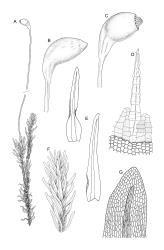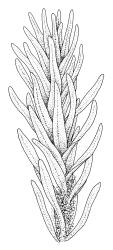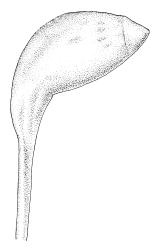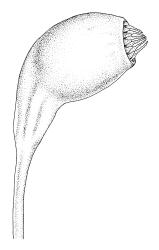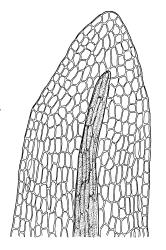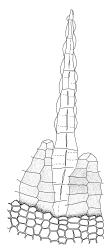- = Meesia macrantha Mitt., Hooker's J. Bot. Kew Gard. Misc. 8: 260 (1856) nom. illeg.
- = Meesia muelleri Müll.Hal. & Hampe, Linnaea 28: 208 (1856) – as mülleri
- = Meesia aquatica R.Br.bis, Trans. & Proc. New Zealand Inst. 31: 465 (1899)
- = Meesia aquatilis R.Br.bis, Trans. & Proc. New Zealand Inst. 31: 465 (1899)
- = Meesia buchananii R.Br.bis, Trans. & Proc. New Zealand Inst. 31: 464 (1899) – as buchanani
- = Meesia kirkii R.Br.bis, Trans. & Proc. New Zealand Inst. 31: 463 (1899)
Plants yellow-green. Stems simple or branching by subperigonial innovation, <15–55 mm, green above, becoming brown or black below, in cross-section with 2 layers of firm-walled cortical cells and a central strand, densely beset with coarsely papillose, chocolate brown rhizoids. Leaves erect-spreading when moist, weakly crisped when dry, oblong-lingulate or ovate-lanceolate, broadly rounded at apex, (1.0–)1.7–3.2 × c. 0.6 mm, in several ranks, not decurrent, entire, in cross-section broadly V-shaped and with plane or recurved margins; upper laminal cells oblong or rectangular, c. 24–40 × 10–12 μm, firm-walled, shorter at extreme apex; basal laminal cells thinner-walled and longer; alar cells not differentiated or somewhat shorter than adjacent cells. Costa broad, c. ⅓–½ the leaf width at base, somewhat undulate in upper leaf, in cross-section protruding mainly on abaxial surface, cells of ± uniform size throughout, lacking stereids. Axillary hairs numerous and conspicuous, usually remaining attached to stem when leaves are removed, the lowermost 2–3 cells red-brown and the terminal cells hyaline and cylindric.
Autoicous in N.Z. material. Perichaetia appearing lateral due to innovation; perichaetial leaves longer (to c. 3.7 mm) but otherwise similar to vegetative, enclosing archegonia and a few filiform paraphyses (with cylindric terminal cells). Perigonia inconspicuous, with broadly ovate bracts surrounding numerous antheridia and numerous clavate paraphyses (6–10 cells and c. 150–180 μm long, with an oblong to globose, and weakly inflated terminal cells). Setae very long, (12–)20–40 mm, twisted to the right below and to the left above, yellow-brown; capsules suberect, asymmetric, and sharply curved from a clearly defined and long neck (c. ⅓ to ½ the total capsule length), smooth, elongate-pyriform with an oblique mouth, c. 2.5–3.0 mm, pale red-brown at maturity; exothecial cells mostly short oblong, firm-walled, occasionally weakly thickened at corners, oblate and darker in several rows at mouth; endostomal cilia rudimentary. Calyptra c. 3 mm. Spores spherical, 45–54 μm, finely bullate.
Crum & Anderson 1981, fig. 295; Matteri & Ochyra 1999, figs 4–5; Smith 2004, fig. 170, 3–5; Ochyra et al. 2008, fig. 227.
SI: Nelson, Marlborough (Fish Lake), Canterbury, Otago, Southland (South Branch Eglinton River, Te Ānau); Ch.
Bipolar. Mainland Australia*, North America*, Europe*, and Asia. Recorded from temperate South America by Matteri & Ochyra (1999), and the Antarctic Peninsula and its associated islands by Ochyra et al. (2008).
On wet humic soil in mineral-rich sites, often at stream margins in tussock grasslands, in fens and marshes (including those dominated by Typha orientalis). Also in seepages within Oreobolus pectinatus-dominated cushion bogs and sometimes associated with Schoenus pauciflorus on wet, ± vertical banks. Campyliadelphus stellatus is a very frequent associate and less commonly Breutelia pendula, Drepanocladus aduncus, Fissidens adianthoides, Philonotis tenuis, and various Bryum spp. Meesia uliginosa can dominate areas of several square metres extent. Occurring from near sea level (in coastal Otago) to c. 1500 m (Criffel Range, Otago L.D.), but rare below c. 500 m.
Known from Chatham Is only from a single non-localised collection by T. Kirk (CHR 524906). The absence of records from the North I. is curious and could reflect the paucity of appropriate habitats there or simply be a collection artefact; Sainsbury (1955) also remarked on the absence of North I. collections.
Apparent annual growth increments can occasionally be seen in material from higher elevations (e.g., J. Child 6049, Old Man Range, Otago L.D., CHR 430790). Scott & Stone (1976, p. 304) cite Australian material with stems to 90 mm.
Although some N.Z. material has vegetative leaves shorter than representative for the species, it falls well within the range of continuous variation in the northern hemisphere material. Several Australasian treatments, including Dixon (1926); Sainsbury (1955); and Bell & Catcheside (2006) have persistently used the name Meesia muelleri Müll.Hal. & Hampe for this species. The use of this name in the Australasian literature seems to reflect a regional bias and a reluctance to compare Australasian material to the predominantly northern hemisphere M. uliginosa Hedw.
Five of the names treated as synonyms here were initially synonymised with M. muelleri by Dixon (1926). Meesia muelleri and M. macrantha, both Australian names that have been applied to N.Z. material, were described from duplicates of one F. Mueller collection from Mt Cobberas in the Victorian Alps. There are several duplicates of the Mueller collection ("in sphagnetis mountis Cobberas") in MEL (P. Milne, pers. comm., 5 Aug. 2014). Bell & Catcheside (2006) designated material in BM-Hampe (apparently the same specimen cited in the synonymy above) as the holotype of M. muelleri Müll.Hal. & Hampe, but they apparently did not sight this specimen.
Meesia uliginosa is such a distinctive plant that confusion with any other N.Z. species seems unlikely. Dixon (1926, p. 224) aptly described it (as M. muelleri) as "a usually tall, richly fruiting, paludal moss, with oblong-lingulate, widely obtuse, entire leaves, somewhat lax, pellucid, subquadrate, smooth upper cells, and nerve ceasing much below apex".




